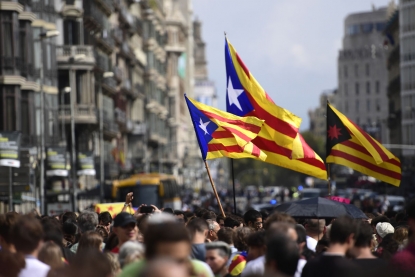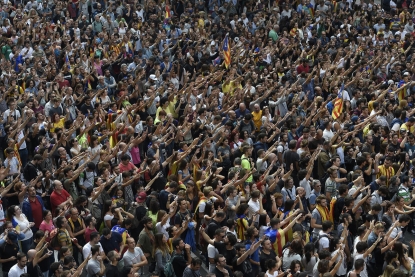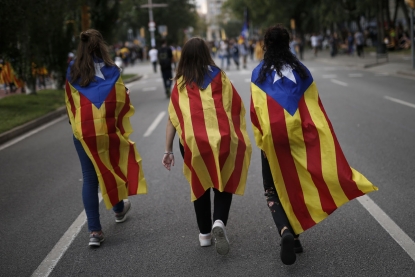Nine yellow dots in Barcelona
With violent protests gripping Barcelona after its fugitive former leader was arrested abroad, AFP’s Madrid deputy bureau chief Michaela Cancela-Kieffer recounts a magical moment during the previous wave of demonstrations last October, when Catalonia declared independence. The streets were filled with people, you could feel the tension, violence seemed moments away. Then nine yellow dots appeared.
 A demonstration outside the Spanish national police headquarters in Barcelona on October 2, 2017.
(AFP / Pau Barrena)
A demonstration outside the Spanish national police headquarters in Barcelona on October 2, 2017.
(AFP / Pau Barrena)Barcelona -- Anguish gripped me. I had hardly slept. Spent the night tossing and turning in an immense AirBnb apartment that I was sharing with five AFP colleagues in Barcelona.
It was October 2017 and the images that we had broadcast to the world from the Catalan capital haunted me. Plastic voting urns. Police in full riot gear. Demonstrators screaming insults at a hotel where federal Spanish police sent up as reinforcements were staying.
I am French and Spanish. Born in France, raised in Madrid. Granddaughter of a military man from Spain’s Galicia region and a resistance fighter from France’s Alsace region. In Madrid, I grew up during the “Movida,” when life seemed like a never-ending party of liberty that followed the death of dictator Franco. Everything seemed to be moving at a breakneck pace back then. Catalonia? To a Spaniard from Madrid like me, it was the avant-garde, the Olympic Games of 1992, a source of good-natured rivalry between Madrid and Barcelona.
And now here I am, covering Catalonia voting to split from Spain. As a Spaniard, the whole story makes me dizzy. As a French national, I don’t understand what’s going on. As an AFP journalist, I am trying to avoid the traps and manipulations of both sides in this increasingly heated debate -- they come not only from official channels, but from family and friends. So you can understand why I couldn’t get to sleep.
 A protest in Barcelona on October 2, 2017. (AFP / Pierre-philippe Marcou)
A protest in Barcelona on October 2, 2017. (AFP / Pierre-philippe Marcou)Catalonia catapulted to world headlines after police violence marred its controversial independence referendum, which was ruled illegal by the Spanish courts that also also instructed police to prevent it. The following day, October 3, saw a huge demonstration in Barcelona against the violence. We had to think quickly of how to organize coverage for this unexpected top world news story. The tension was so thick, you could almost see it. Spontaneous demonstrations were flaring in other towns; violence could break out again at any moment.
Sitting in AFP’s bureau, near the Ramblas Avenue tourist spot that was the target of a jihadist attack in August, I could hear the demonstrators. The city seemed to be filled with young people who were peacefully singing one moment, and hurling insults at police helicopters the next.
In a sign of just how high emotions were running, a spokesman for the country’s main police union told me nervously that the State was losing control of Catalonia.
Around 6:00 pm we huddled in the bureau over a map of the city. Each one got a section to cover. There were about 15 of us and many had come from other bureaus to help out, so they didn’t know Barcelona. Photographers and video journalists put on their helmets and bullet-proof vests.
The Spanish media had for days been voicing concern that violence can break out over this Catalan secession bid. But on the street I saw scenes that reassured me. The demonstrators seemed peaceful. I saw a couple sporting flags like capes -- she a Spanish one, he a Catalan one.
Then I got a call from Daniel Bosque, our Barcelona correspondent. He was in another spot, where some demonstrators wanted to go and hold a protest against “repression” in front of the national police headquarters. Others were saying it was a bad idea and a recipe for a confrontation. I started walking faster toward them.
Suddenly hundreds, then thousands of people were on the move toward the national police headquarters on Via Laietana. “Out with the occupation forces!” they chanted in unison. It was becoming more difficult to move around.
 A protest in Barcelona, October 3, 2017. (AFP / Lluis Gene)
A protest in Barcelona, October 3, 2017. (AFP / Lluis Gene)Around 9:00 pm, one of my social media feeds announced the arrival of “provocateurs” at the site of the police headquarters. I began to look for a vantage point from where I could observe this mass of a demonstration, in case trouble started.
I was finally able to get into a building just in front of police headquarters and went from floor to floor, knocking on doors. On the third floor, Maite, a pensioner and an independence supporter, let me inside her apartment.
As she guided me through what seemed like a corridor with no end, she was saying “I don’t know when my son will get here. He is supposed to come home from an internship, I hope he gets home quickly.”
Finally we ended up in a small living room where her husband -- who like me didn’t get a good night’s sleep -- was trying to take a nap. Night was falling.
Maite opened the huge windows to her balcony. The din of the demonstrators below rushed into the room. We leaned out to get a better look. There were at least 15,000 people below. All that was separating them from the police headquarters were barriers and two or three vans filled with regional police.
It was around 20:20. Maite stood on her balcony, her arms opened wide, repeating “calm, calm” to the roar below. I watched about a dozen of police who stood just outside the entrance to their headquarters. Silent statues absorbing wave after wave of insults. “Sons of whores!” screamed the demonstrators just in front of them.
I thought to myself, “what if one of the protesters throws a beer bottle or another projectile? They’ll feel trapped and will react like hunted animals.”
 Members of the Spanish National Police stand guard during a protest in Barcelona, October 1, 2017. (AFP / Pau Barrena)
Members of the Spanish National Police stand guard during a protest in Barcelona, October 1, 2017. (AFP / Pau Barrena)Then suddenly Maite and I saw a dozen or so yellow dots move through the tightly-packed crowd, which seemed to part in front of them. Then, in a few minutes, thousands of people left Via Laietana. In only a few minutes, half of the people seemed to melt away. The yellow dots continued to move forward. And as they did, the crowd in front of them dispersed. Maite and I didn’t know what to think.
Finally the yellow dots made it to the head of the protest, right in front of police headquarters. I could now see that the dots were actually humans, dressed in yellow and wearing yellow helmets. Maite recognized them. She told me that they were wearing the uniform of a forest defense association (ADF) that was formed in the 1980s after a particularly nasty forest fire in Catalonia, to prevent and fight wildfires. They were widely respected by everyone in the region.
At 20:50, only a few handful of protesters remained where a half hour earlier there was a huge, angry, menacing crowd, with fears that it could quickly turn violent.
Both Maite and I were relieved. We said good-bye to each other warmly, like two people who had gone through an intense experience together.
As I walked out of her building into the now nearly empty street outside, I was intrigued by these men who managed to disperse a demonstration of some 15,000 people in a few minutes. I have covered plenty of demonstrations in my journalistic life and I’ve never seen anything quite like it. Usually a situation as tense as what I saw doesn’t just dissipate within a few minutes. It simmers until either the police intervenes or the protesters decide to leave.
I set out to learn more about these mysterious creatures.
 The firefighters huddle after having diffused the confrontation on October 2, 2017 in Barcelona. (D.R.)
The firefighters huddle after having diffused the confrontation on October 2, 2017 in Barcelona. (D.R.)I wrote to Marc, the head of the association, who agreed to tell me their story. Eventually I spent several hours interviewing five of the men who so magically intervened that day.
I was surprised to learn how young they were -- Francesc, a musician, and Joel, a computer information student, were both 18; Paul was a 20-year-old actor; Marc was a was 25-year-old first responder; only Enric, a professional firefighter, was more than 30. As a group, they all came to Barcelona that day to denounce the violence; individually, they were both from pro- and anti-independence camps.
During the protest, another association asked for their help in dispersing the demonstrators. So they made their way through, armed with a megaphone. “You have to leave now!” they told the crowd. “This demonstration was against violence, no?” “Leave!”
Some protesters pushed back “Why us? Let them leave!” they yelled, pointing to the police.
They made sure to stick together “as one,” Paul told me. I asked Enric if he was afraid. “Afraid? Of course, the whole time. If the people moved against the police, we would have been caught in the middle.”
Once the protesters dispersed, the head of the Catalan police Mossos on the scene came to congratulate them. “We looked at each other,” Enric said. “And said, ‘we did good work today. Like when we put out a fire.’”
 Barcelona, September 28, 2017. (AFP / Pau Barrena)
Barcelona, September 28, 2017. (AFP / Pau Barrena)



